A 48-square-foot balcony in downtown Chicago transformed from a bare concrete slab into a lush urban retreat with just seven strategic plant choices. You’ll discover how to maximize limited outdoor space while creating your own private oasis, whether you’re seeking edible options or purely decorative greenery. From space-saving vertical solutions to low-maintenance succulents, these proven plant combinations will help you design a personalized balcony garden that thrives in your specific conditions.
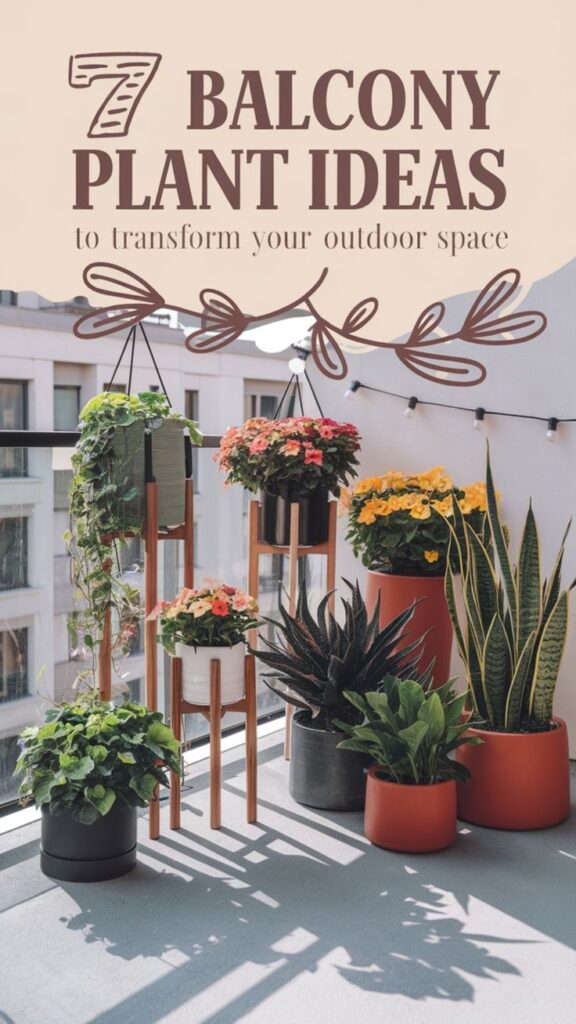
Contents
Space-Saving Vertical Garden Plants
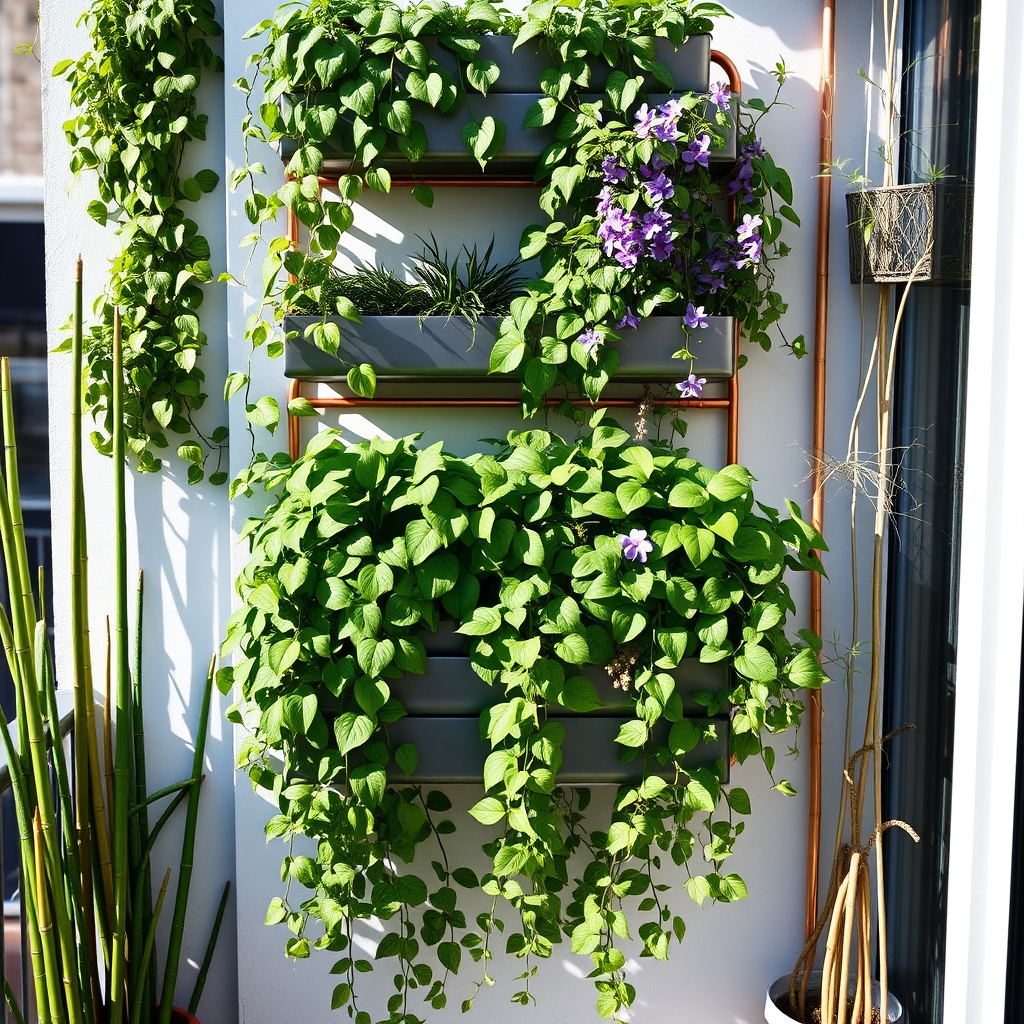
Description:
Vertical garden plants are specially selected species that grow upward or cascade downward, maximizing limited balcony space. These include climbing vines, trailing plants, and compact columnar varieties that can be arranged on wall-mounted planters, trellises, or tiered systems.
Growing Conditions:
- Light requirements vary by species but generally need 4-6 hours of direct sunlight daily
- Well-draining potting soil with organic matter
- Regular watering schedule, typically when top inch of soil feels dry
- Temperature range of 60-80°F (15-27°C)
- Good air circulation to prevent fungal issues
Recommended Plants:
- Climbing plants: Clematis, Morning Glory, Jasmine
- Trailing plants: Pothos, String of Pearls, Ivy
- Compact upright plants: Bamboo, Snake Plant, Columnar herbs
Maintenance Tips:
- Prune regularly to control growth and maintain shape
- Check support structures weekly for stability
- Fertilize monthly during growing season
- Monitor for pest infestations, especially in dense plantings
- Clean leaves periodically to remove dust
- Rotate containers periodically for even growth
- Trim dead or yellowing foliage promptly
Colorful Flowering Container Plants
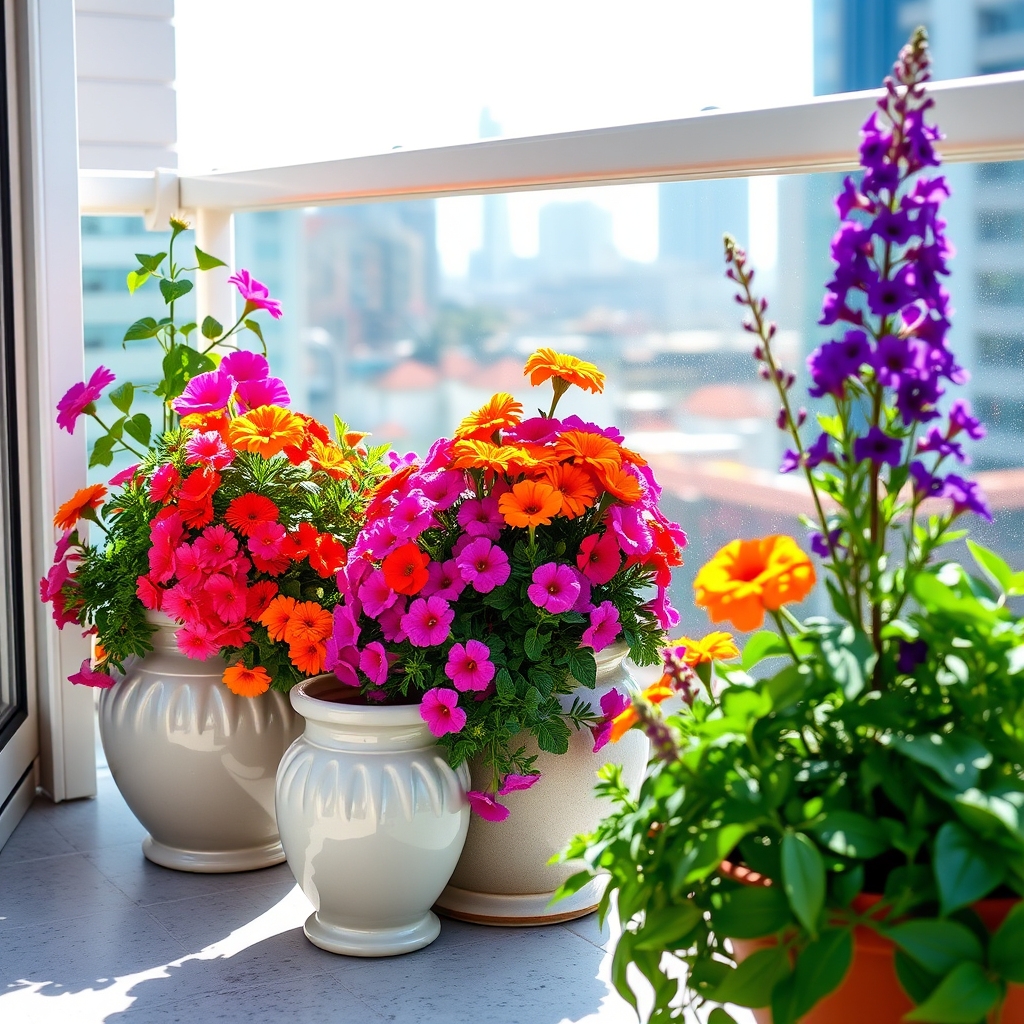
Description:
Flowering container plants add vibrant bursts of color and visual interest to balcony spaces. Popular options include petunias, geraniums, marigolds, verbena, and calibrachoa.
These plants typically produce blooms in various colors from spring through fall, with cascading or upright growth habits that work well in containers, window boxes, and hanging baskets.
Growing Conditions:
- Light: Most flowering containers need 6-8 hours of direct sunlight daily
- Water: Consistent moisture; water when top inch of soil feels dry
- Soil: Well-draining potting mix enriched with organic matter
- Temperature: 60-80°F (15-27°C)
- Container: Pots with drainage holes, sized appropriately for plant variety
- Spacing: Follow specific variety recommendations for container spacing
Maintenance Tips:
- Deadhead spent blooms regularly to encourage continuous flowering
- Fertilize every 2-4 weeks with balanced, water-soluble fertilizer
- Prune leggy growth to maintain compact shape
- Check soil moisture daily during hot weather
- Monitor for pests like aphids and spider mites
- Replace seasonal plants as needed based on bloom cycles
- Clean containers and refresh soil annually
- Protect sensitive varieties from strong winds and extreme weather
Low-Maintenance Succulents and Cacti

Succulents and cacti are drought-resistant plants with thick, fleshy leaves or stems that store water. These plants come in diverse shapes, sizes, and colors, from compact rosettes to tall, columnar forms. Popular balcony varieties include Echeveria, Sedum, Aloe vera, and barrel cacti.
Growing Conditions:
- Sunlight: Bright, direct sunlight for 6+ hours daily; morning sun is preferable
- Water: Minimal watering; allow soil to dry completely between waterings
- Soil: Well-draining cactus mix or regular potting soil mixed with sand and perlite
- Temperature: Tolerates heat well; protect from frost (most varieties prefer 60-80°F)
- Containers: Terracotta or ceramic pots with drainage holes
Maintenance Tips:
- Water deeply but infrequently, reducing water in winter
- Remove dead leaves and spent blooms
- Rotate pots quarterly for even growth
- Check for pests like mealybugs and scale insects
- Repot every 2-3 years or when outgrowing container
- Apply diluted cactus fertilizer during growing season
- Protect from excessive rainfall and standing water
Fragrant Herbs for a Kitchen Garden
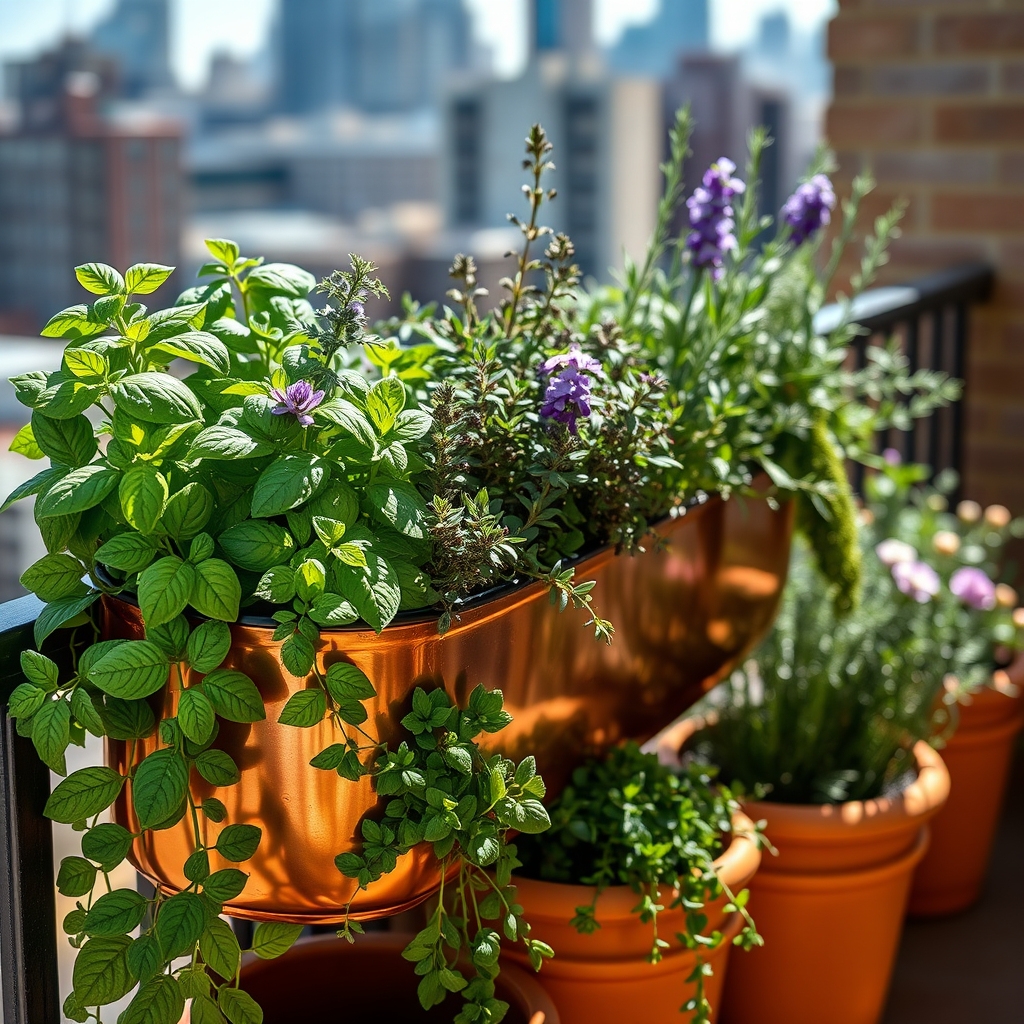
Fragrant herbs create an aromatic and practical addition to balcony gardens, offering fresh ingredients for cooking while requiring minimal space. Common balcony-friendly herbs include basil, thyme, rosemary, mint, oregano, and chives.
These plants range from low-growing spreaders to upright bushes, featuring varied leaf textures and colors, plus delicate flowers when in bloom.
Growing Conditions:
- 6-8 hours of direct sunlight daily, with afternoon shade in hot climates
- Well-draining potting soil mixed with 30% perlite
- Containers with drainage holes, at least 6 inches deep
- Moderate watering when top inch of soil feels dry
- Temperature range of 65-70°F (18-21°C)
- Monthly feeding with balanced, water-soluble fertilizer
Maintenance Tips:
- Harvest herbs regularly to encourage bushier growth
- Pinch off flower buds to maintain leaf production
- Trim back leggy stems to promote compact growth
- Rotate containers weekly for even growth
- Check for pests like aphids and spider mites
- Replace soil annually and repot when roots become crowded
- Keep different mint varieties in separate containers to prevent spreading
Climbing Plants and Vines for Privacy
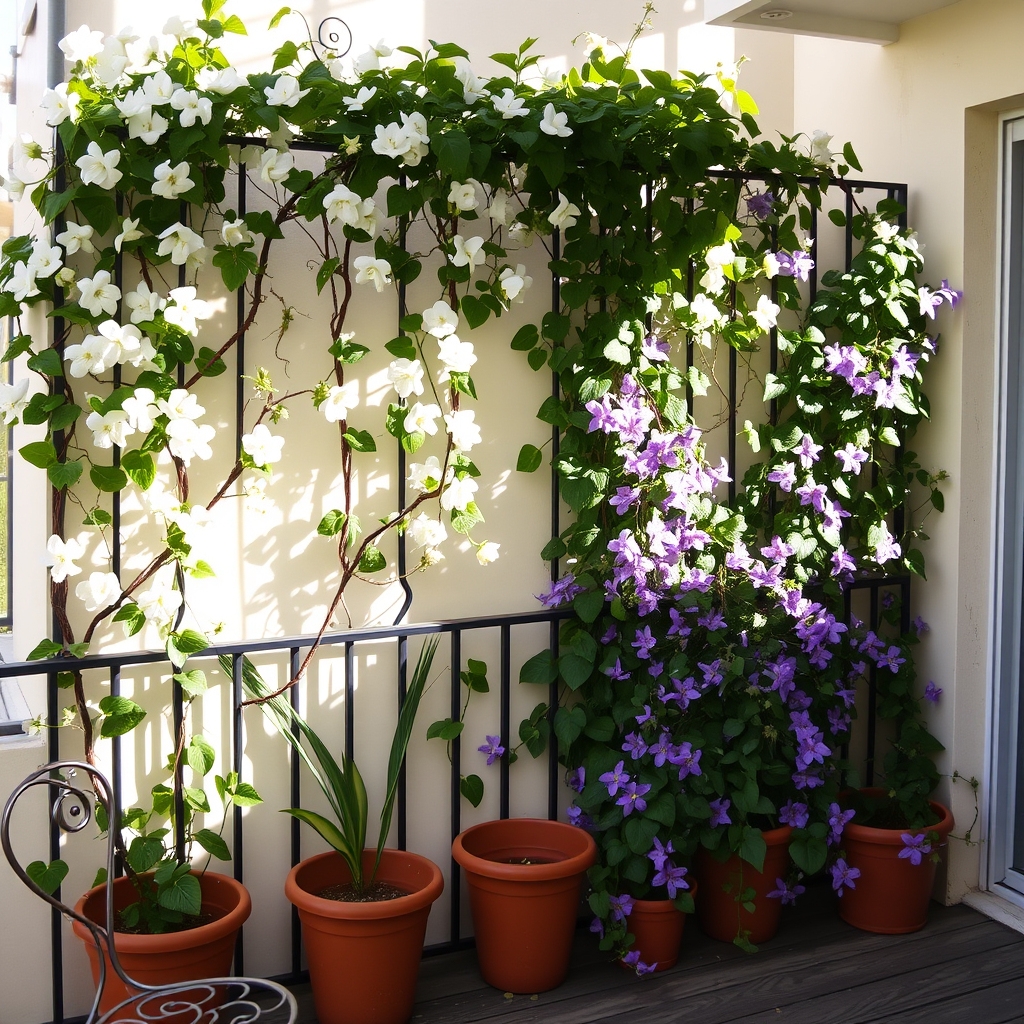
Climbing plants and vines create natural privacy screens on balconies by growing vertically along trellises, railings, or walls. These plants offer lush foliage, seasonal flowers, and can transform bare spaces into green sanctuaries.
Popular options include clematis, ivy, jasmine, morning glory, and climbing roses.
Growing Conditions:
- Sunlight: Most climbing plants need 4-6 hours of direct sunlight daily
- Soil: Well-draining potting mix rich in organic matter
- Container: Deep containers (12-18 inches) with drainage holes
- Support structure: Sturdy trellis, wire mesh, or string systems
- Water: Consistent moisture without waterlogging
- Temperature: Varies by species; most prefer 60-75°F (15-24°C)
Maintenance Tips:
- Train young vines by gently weaving them through support structures
- Prune regularly to control growth and remove dead foliage
- Feed with balanced fertilizer during growing season
- Check support structures periodically for stability
- Monitor for pests like aphids and spider mites
- Trim back aggressive growth to prevent overwhelming balcony space
- Clean fallen leaves and debris to prevent disease
- Protect sensitive varieties from strong winds and extreme weather
Compact Fruit and Vegetable Options
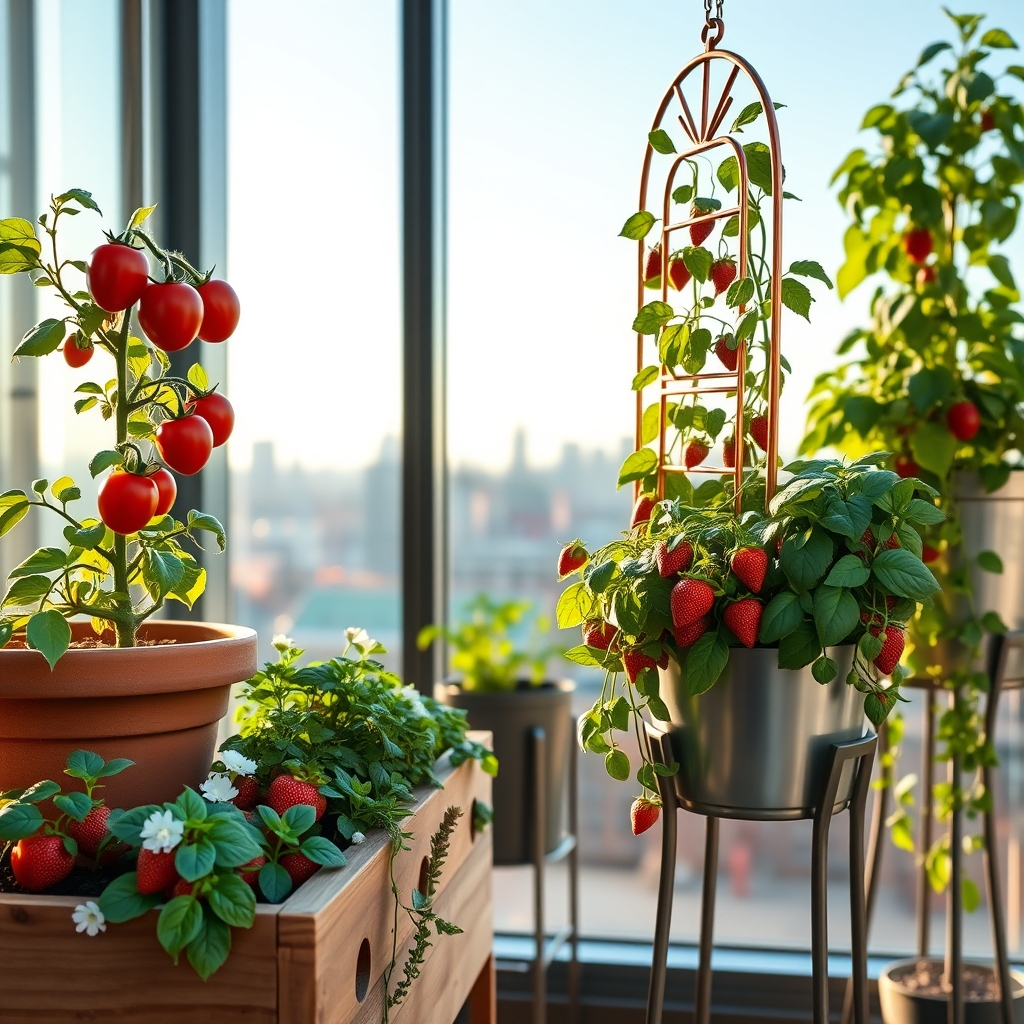
Growing fruits and vegetables on a balcony is possible with dwarf varieties and container-friendly plants. Popular options include cherry tomatoes, bush beans, compact peppers, strawberries, and herbs. These plants typically grow 1-3 feet tall and can thrive in containers ranging from 12-24 inches deep, making them ideal for limited spaces.
Ideal Growing Conditions:
- 6-8 hours of direct sunlight daily
- Well-draining potting soil enriched with organic matter
- Containers with drainage holes
- Temperature range of 65-85°F (18-29°C)
- Regular watering to maintain consistently moist soil
- Monthly fertilizer application during growing season
Maintenance Tips:
- Rotate containers periodically to ensure even light exposure
- Prune regularly to maintain compact growth
- Monitor for pests, especially aphids and spider mites
- Support climbing varieties with small trellises or cages
- Harvest produce regularly to encourage continued production
- Clean fallen leaves and debris to prevent disease
- Check soil moisture daily during hot weather
- Replace soil annually to maintain nutrient levels
Ornamental Grasses and Bamboo
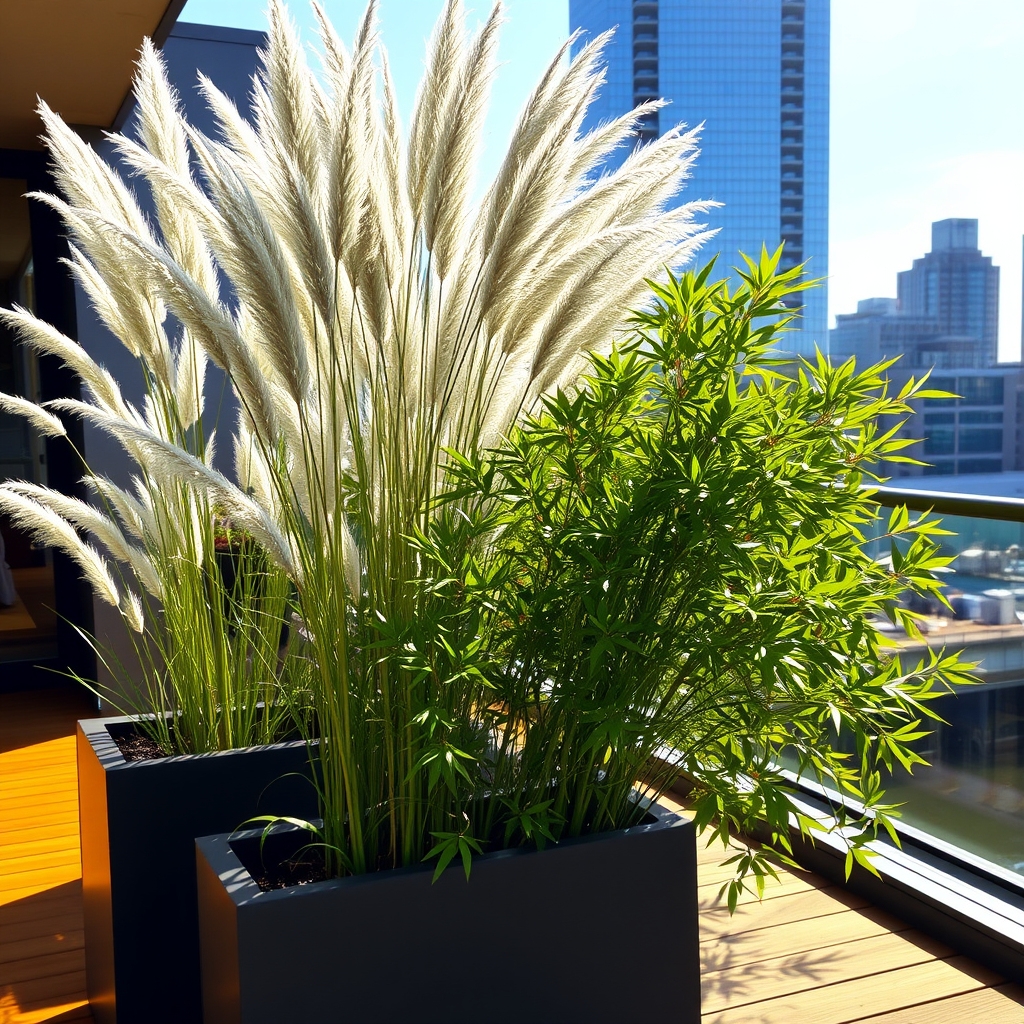
Description:
Ornamental grasses and bamboo add dramatic vertical interest and movement to balcony spaces. These plants feature graceful, swaying stems and leaves that create gentle rustling sounds in the breeze.
Ornamental grasses display various colors, from bright green to burgundy, while bamboo varieties range from delicate, clustered stems to thick, towering culms.
Growing Conditions:
- Light: Most varieties prefer full sun to partial shade
- Water: Regular watering with well-draining soil; bamboo requires more frequent watering
- Soil: Well-draining potting mix enriched with organic matter
- Temperature: Most varieties tolerate temperatures between 40-90°F (4-32°C)
- Container: Deep containers with drainage holes to accommodate extensive root systems
- Space: Allow adequate spacing between plants for air circulation
Maintenance Tips:
- Cut back ornamental grasses in late winter before new growth emerges
- Control bamboo spread by choosing clumping varieties and using root barriers
- Remove dead foliage regularly
- Divide overcrowded plants every 2-3 years
- Fertilize monthly during growing season with balanced fertilizer
- Monitor soil moisture, especially during hot periods
- Prune yellowed or damaged stems at the base
- Check containers regularly for stability, particularly in windy conditions
